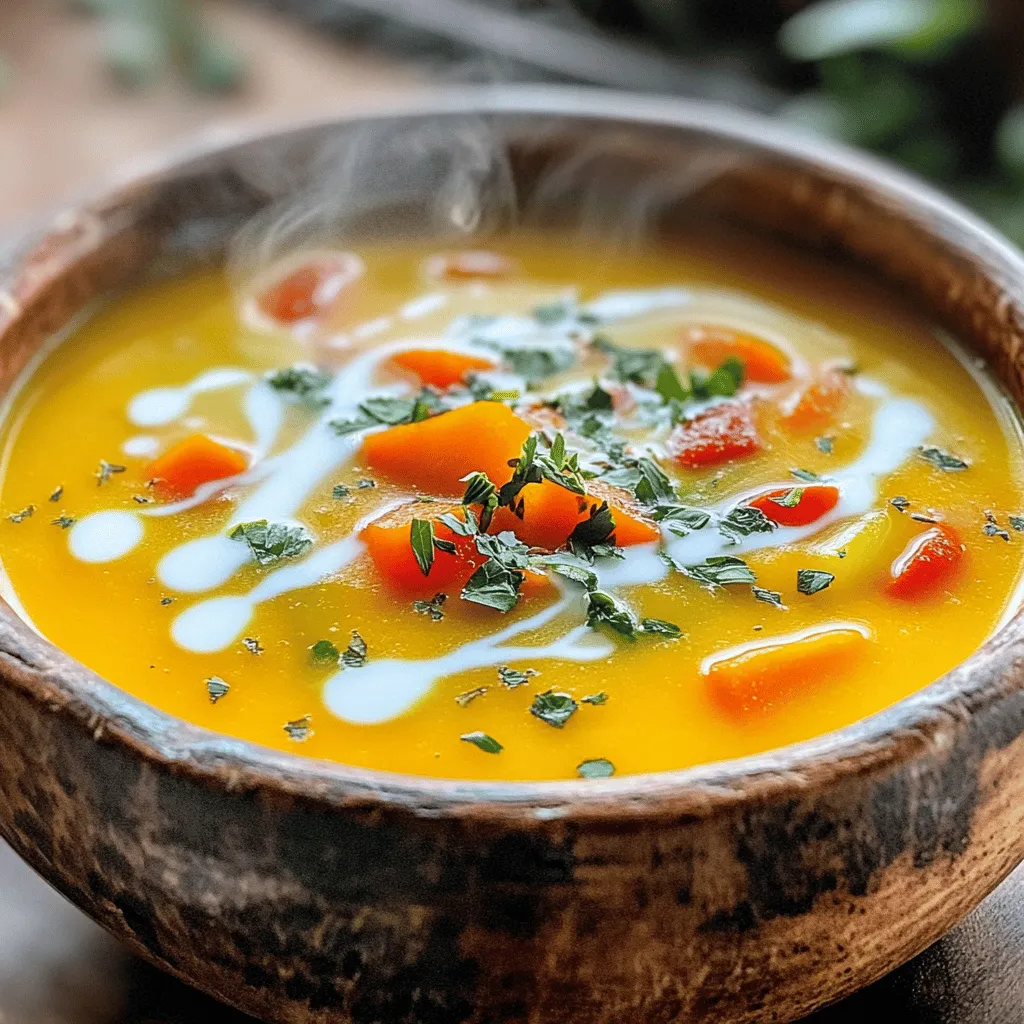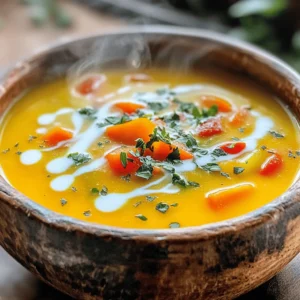As the chilly nights draw in, there’s nothing quite like a warm bowl of silky roasted vegetable soup to soothe the soul. This rich, creamy dish combines fresh veggies and flavorful herbs, perfect for cozy dinners. I’ll guide you through each step, ensuring you create a comforting meal that not only warms your body but also delights your taste buds. Ready to discover your new favorite soup recipe? Let’s get started!

Ingredients
Fresh Vegetables and Herbs
– 2 cups carrots, peeled and chopped into bite-sized pieces
– 2 cups butternut squash, peeled and cubed into 1-inch pieces
– 1 red bell pepper, seeded and chopped
– 1 medium onion, diced
– 4 cloves garlic, peeled and left whole
You can also use seasonal vegetables. Try zucchini, sweet potatoes, or parsnips. Just adjust the roasting time if they need more or less heat.
Pantry Staples
– 3 tablespoons extra virgin olive oil
– 4 cups vegetable broth, low-sodium preferred
– 1 teaspoon dried thyme
– 1 teaspoon smoked paprika
– Salt and freshly ground pepper, to taste
These staples help create a rich and flavorful base for your soup. They add depth to the roasted vegetables.
Creamy Addition
– ½ cup full-fat coconut milk
Coconut milk makes the soup creamy and rich. If you want a different option, try cashew cream or almond milk. Both can add creaminess while keeping the soup light.
Step-by-Step Instructions
Preparing the Vegetables
1. Preheat the oven to 400°F (200°C). This helps roast the veggies perfectly.
2. In a large bowl, mix the carrots, butternut squash, red bell pepper, onion, and garlic. Make sure they are all cut into similar sizes.
3. Cutting tips: Chop the carrots into bite-sized pieces. Cube the butternut squash into 1-inch pieces. Dice the onion small so it cooks well. Keep the garlic whole to add sweetness.
Roasting the Vegetables
1. Best practices: Spread the veggies in a single layer on a baking sheet. This helps them roast evenly.
2. Toss them halfway through cooking. This way, every side gets nice and brown.
3. Caramelization: This process adds deep flavor. It makes the veggies sweet and tasty. Look for golden edges when they are done.
Blending and Finalizing the Soup
1. Blending tips: Use an immersion blender for easy pureeing. If you use a traditional blender, blend in small batches. This helps avoid spills.
2. Adjusting consistency: After blending, add coconut milk for creaminess. If it’s too thick, add more vegetable broth.
3. Seasoning: Taste the soup. Add more salt, pepper, or spices as needed. This makes sure every bite is tasty.
Tips & Tricks
Perfecting the Flavor
To make your soup even better, you can adjust the seasoning. Try adding a pinch of cayenne for heat or a splash of lemon juice for brightness. If you want a deeper flavor, roast the garlic until golden. The size of your vegetables matters, too. Larger pieces take longer to roast. Cut your veggies to about the same size for even cooking and roasting.
Achieving a Silky Texture
Coconut milk gives the soup its creamy feel. When blending, make sure to mix until smooth. If your blender struggles, add a little broth to help it out. If it’s too thick, add more broth or coconut milk to reach your desired texture. Always blend in batches if your blender is small. This makes it easier to achieve that silky finish.
Presentation Tips
Serving the soup can be fun! Use warm bowls to keep the soup hot. For extra flair, drizzle some coconut milk on top. This creates a lovely swirl. Finish with fresh herbs like basil or parsley. They add color and a fresh taste. You can also add croutons for crunch or a sprinkle of smoked paprika for a pop of color. Enjoy making your soup not just delicious but beautiful, too!

Variations
Adding Proteins
You can make this soup heartier by adding proteins. Beans or lentils work well in this dish. Black beans or chickpeas add a nice texture and flavor. Just rinse them well before adding them to the soup. You can also use cooked lentils. They blend in beautifully and add nutrition.
If you want a meat option, try using chicken. You can add shredded cooked chicken right before serving for extra flavor. You can also swap vegetable broth for chicken stock. This change will add a savory depth to your soup.
Spicy Version
If you like some heat, you can spice things up! Adding chili flakes is a simple way to do this. Start with a pinch and add more if you want. You can also chop up jalapeños. Add them during the roasting phase for a warm kick. This will give your soup a nice depth of flavor.
Adding Grains
To make your soup more filling, consider adding grains. Quinoa is a great choice. It cooks quickly and adds protein. You can also use rice or barley. Just cook them separately and stir them into the soup before serving. This will give you a hearty meal that warms you up on cold nights.
Storage Info
Refrigeration
To store your silky roasted vegetable soup, let it cool down first. This helps keep it fresh. Pour the soup into an airtight container. It can last in the fridge for about four to five days. Always check for any changes in smell or texture before using it again.
Freezing Instructions
If you want to save some for later, freezing is a great option. Pour the cooled soup into freezer-safe containers. Leave some space at the top for expansion. Seal tightly and label with the date. The soup can stay good in the freezer for up to three months. When you’re ready to eat it, thaw it in the fridge overnight. Reheat it on the stove over low heat. Stir it often to keep it smooth and creamy.
Repurposing Leftovers
You can get creative with leftover soup. Use it as a sauce over pasta or grains. It can also work great as a base for casseroles. Pour it into a baking dish, add some cooked chicken or beans, and top with cheese. Bake until bubbly for a tasty meal. Another idea is to blend it with some fresh greens for a quick smoothie or savory shake.
FAQs
How can I make this soup vegan?
To make this soup vegan, use coconut milk and vegetable broth. Both are plant-based and perfect for a creamy texture. When buying vegetable broth, check the label to ensure it contains no animal products. This simple swap keeps your soup rich and satisfying while making it vegan-friendly.
Can I use frozen vegetables?
Yes, you can use frozen vegetables. Just remember, frozen veggies may need less roasting time. Check them after 20 minutes to see if they are soft. If you roast them too long, they might get mushy. Adjust your cooking time to get the right texture.
Is this soup gluten-free?
Yes, this soup is gluten-free. All the ingredients are free from gluten. Just be sure that your vegetable broth is labeled gluten-free. This way, you can enjoy a safe and tasty meal without worrying about gluten.
This blog post walked you through creating a delicious vegetable soup. We covered fresh vegetables, pantry staples, and creamy additions. You learned how to prepare, roast, and blend the ingredients for the best flavor and texture.
In the end, feel free to experiment with proteins, spices, or grains to suit your taste. Don’t forget about storage tips for refrigeration and freezing. Enjoy exploring different variations to keep it exciting and fresh!

